Beginning the Church’s liturgical year, Advent (from, “ad-venire” in Latin or “to come to”) is the season encompassing the four Sundays (and weekdays) leading up to the celebration of Christmas.
The Advent season is a time of preparation that directs our hearts and minds to Christ’s second coming at the end of time and to the anniversary of Our Lord’s birth on Christmas. From the earliest days of the Church, people have been fascinated by Jesus’ promise to come back. But the scripture readings during Advent tell us not to waste our time with predictions. Advent is not about speculation. Our Advent readings call us to be alert and ready, not weighted down and distracted by the cares of this world (Lk 21:34-36). Like Lent, the liturgical color for Advent is purple since both are seasons that prepare us for great feast days. Advent also includes an element of penance in the sense of preparing, quieting, and disciplining our hearts for the full joy of Christmas.
As we prepare for Christmas, the General Instruction of the Roman Missal notes some differences to the Mass that should be observed during the season. For instance, the priest wears violet or purple during Advent, except for the Third Sunday of Advent (Gaudete Sunday) when rose may be worn (GIRM, no. 346). Aside from what the priest wears, other aesthetic changes in the Church can include a more modestly decorated altar.
The final days of Advent, from December 17 to December 24, we focus on our preparation for the celebrations of the Nativity of our Lord at Christmas. In particular, the “O” Antiphons are sung during this period and have been by the Church since at least the eighth century. They are a magnificent theology that uses ancient biblical imagery drawn from the messianic hopes of the Old Testament to proclaim the coming of Christ as the fulfillment not only of Old Testament hopes, but of present ones as well.
Advent devotions including the Advent wreath, remind us of the meaning of the season. Our Advent calendar above can help you fully enter into the season with daily activity and prayer suggestions to prepare you spiritually for the birth of Jesus Christ. More Advent resources are listed below.
Symbols and Customs of Advent
Many people know the popular symbols and customs of Advent, such as the Advent wreath, but do you know their meanings and why we have them? Below is a list of some well known Advent symbols and the meanings behind them.
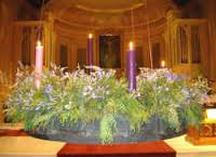
1. The Advent wreath is one of the best known symbols of Advent.
- Traditionally made of evergreen branches formed into a circle with 4 candles held within.
- The evergreen circle is a symbol of eternal life.
- Green from the evergreen is considered a symbol of hope.
- Started as a domestic tradition that entered into churches in the twentieth century.
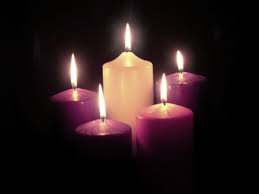
2. Advent Candles are usually comprised of three purple candles with one rose or pink.
- The candles recall the weeks that pass until Christmas.
- Purple candles symbolize waiting, also penitential but not in the same way as Lent.
- Rose or Pink is used on the third Sunday of Advent to symbolize rejoicing, since the Third Sunday of Advent is referred to as Gaudete (Rejoice) Sunday.
- They are lit, light used as a symbol of Christ being the light of the World coming through the darkness.
- Sometimes a white candle is placed in the middle, people use when lit as the representation of Christ entering the world.
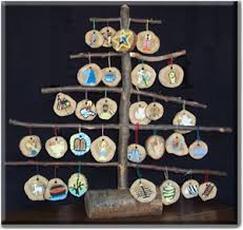
3. The Jesse Tree is named for Jesse the father of King David whose line can be traced to St. Joseph, the earthly father of Jesus.
- Used as a symbol to explain the Old Testament generational connection between Adam, Abraham and Jesus as explained in Gospels Matthew and Luke.
- Popular symbols represent people of the Old Testament including King David as a crown and Noah as a boat.
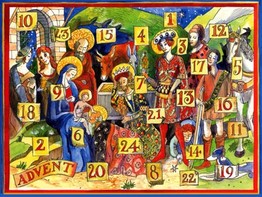
4. An Advent house or Advent calendar show the passing of the days of the season.
- Popular with children, they serve as a way to provide activities and reflections on the season to draw them deeper into the faith. December 24th is usually a scene of the Nativity.
- Used as a visual tool of preparation and patiently waiting for Christ to come into our lives.

5. The Giving Tree is a variation of the Jesse Tree that became popular in the late 20th century.
- The custom has communities decorate a tree with tags indicating gifts for children in need at Christmas.
- Intended to remind Christians of the teaching of Jesus “what you do to the least of these, you do to me” (Mt. 25:40)
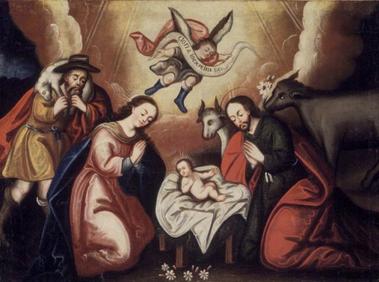
6. Nativity scene or Creche is used to commemorate the humble birth of Christ.
- Created by St. Francis of Assisi in the 13th Century to emphasize the humility of the Savior of the World coming as a poor child.
- There are many different designs and themes used, including stone or wax figurines, as well as human and animal actors.
- In some locations a variation is included that has the manger empty until Christmas Eve as a celebration of Christ’s arrival as a child.
- Culturally, certain countries will change the look of the Creche, including more towers, houses, mountains, than what was traditionally used during the 13th Century.

